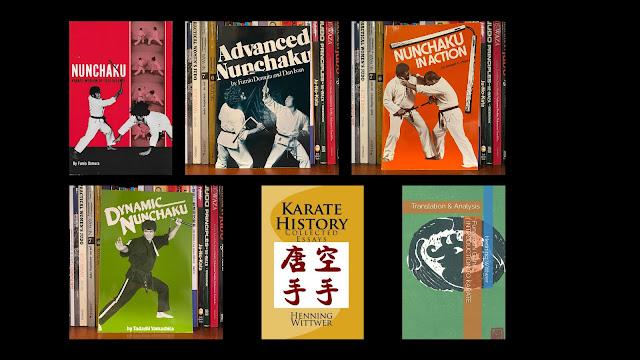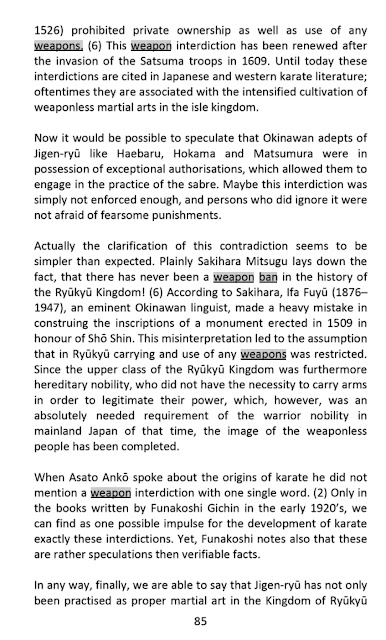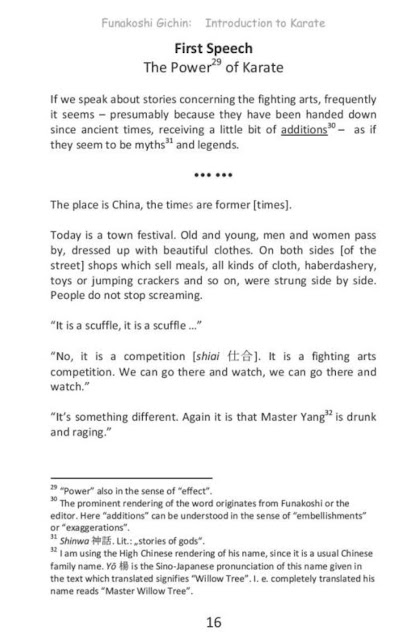June 2023 Book Survey Part 2
Introduction
In June 2023, I (Richard) continued my book survey plan. This post examines several books on karate.
Nunchaku: Karate Weapon of Self Defense, Fumio Demura, 1971
My copy of Nunchaku: Karate Weapon of Self Defense is from the Internet Archive, which has two copies. I prefer this original edition. Sensei Demura passed away recently. so I'm pleased to feature a couple of his books in this post.
This book is about 144 black and white pages. It contains pretty clear photos and the composition is sound. Here are a few excerpts:
The last photo shows one of my favorite aspects of the book -- comparisons between armed and unarmed applications.
This book is worth a look for any martial artist.
Advanced Nunchaku, Fumio Demura & Dan Ivan, 1976
As you can see, I own a print copy of Advanced Nunchaku. Mine is a 1995 13th printing. It is a paperback measuring 5 7/8 inches by 8 7/8 inches with 160 black and white pages. I actually tried learning the weapon with this book in 1995!
The photography in this book is pretty good, and it would be cool to extract and animate images like the following:
The photos tend to be a bit small, but overall I'm impressed that they could capture sensei Demura in motion in 1976!
Nunchaku in Action, Joseph C. Hess, 1983
Nunchaku in Action is another book I bought in the 1990s to learn this weapon. My copy is a 1994 7th printing measuring 5 7/8 inches by 8 7/8 inches with 224 black and white pages. This book offers great execution. Here are a few samples:
There is a ton of content in this book, so nunchaku fans will enjoy it.
Dynamic Nunchaku, Tadashi Yamashita, 1986
Dynamic Nunchaku is the last book on the topic that I bought 30 years ago. My copy is a 1994 5th printing measuring 5 7/8 inches by 8 7/8 inches with 192 black and white pages.
I think it's cool that this book features advice on training with two nunchaku, as shown:
The book sometimes includes arrows to show direction of motion:
This book is also unique in that it shows people using nunchaku in "street self defense" situations!
If you're a nunchaku fan, I would hunt down a copy of this out-of-print book.
Karate History: Collected Essays, Henning Wittwer, 2017
Now we turn to a related topic, but with an historical focus: Karate History: Collected Essays. I am still looking for a book on Japanese arts similar to Peter Lorge's incomparable Chinese Martial Arts history book. That search led me to this book by Henning Wittwer, who has written most of his work in German.
My copy of Mr. Wittwer's book is a print-on-demand paperback measuring 6 inches by 9 inches with 160 black and white pages. It contains 6 essays based on his previously published German material.
He stresses up front that he works mainly with primary sources. As an historian, I was greatly pleased to read this.
In my opinion, page 44 basically justified my purchase of the book. Thanks to Amazon, I can share it with you:
Basically, Mr. Wittwer makes the case that Gichin Funakoshi, founder of Shotokan karate, played a big role in promulgating the myths of Bodhidharma and Chinese martial arts. Where did Funakoshi learn them? He read a book published in 1920 by Yoshida Sohei titled Practise of Soul and Flesh: Miracle Freedom, a Japanese translation of the I-Ching and Hsi-sui Ching, also known as the Classic of Changing the Tendons (see Meir Shahar) or the Classic of Washing the Marrow.
Japanese historian Higaonna Kanjun (1882-1963) wrote "it is an error to believe that karate developed directly from the two doctrines Changing the Tendons and Washing the Marrow," despite what Funakoshi believed and was repeated by later Japanese martial artists. Apparently this quote did not have an impact, despite being published in a book published in 1933 to celebrate Funakoshi's 60th birthday. Because Funakoshi bought into the Tendons and Marrow Bodhidharma myths, subsequent generations of karateka (and Chinese martial artists) did too.
Wittwer notes that Mabuni Kenwa's work also cited the Yoshida book as justification for these ties to Chinese arts, and that the 1915 book The Secrets of Shaolin Boxing was a fake and a farce.
Most interestingly, Wittwer notes there was no weapons ban in the Ryuku kingdom, and no prohibition on karate. He says his German works expand on this more fully. Here are a few excerpts from the work at hand that mention the German source:
The book concludes with interesting issues caused by translations of Funakoshi's works.
While this is not the overall karate or Japanese art history book I've been looking for, its analysis of the source of the Bodhidharma myths was invaluable.
Funakoshi Gichin Introduction to Karate: Translation & Analysis, Henning Wittwer, 2023
I bought a copy of Funakoshi Gichin Introduction to Karate: Translation & Analysis because I figured it was the right companion to the previous title. My copy is a print-on-demand hardcover measuring 6 3/8 inches by 9 1/4 inches with 278 black and white pages. There are a few color pages at the end.
This is a VERY detailed translation, with probably over 500 footnotes. Here is a sample:
This book is a great antidote to any of the popular translations of Funakoshi available elsewhere.
Conclusion
There are no "must buys" in this collection, but if you are interested in authentic karate history, I highly recommend Mr. Wittwer's books.
In the next post we continue our survey of the last print titles in my library.
You may know about our Amazon Wish List. If you would like to help us get books to read and review from that list, then please consider supporting us via Buy Me a Coffee.
If you like this article, check out our Facebook page, Instagram account, Twitter feed, and Amazon Wish List. Be devoted!





























Comments
Post a Comment